“Rice fields, flower banks” breaks the vicious circle in rice cultivation
As rice cultivation area and productivity increases in the Mekong Delta, so does the use of agricultural materials, particularly chemical drugs to control pests. This is also one of the reasons why agricultural products are unsafe and have a negative impact on the environment.
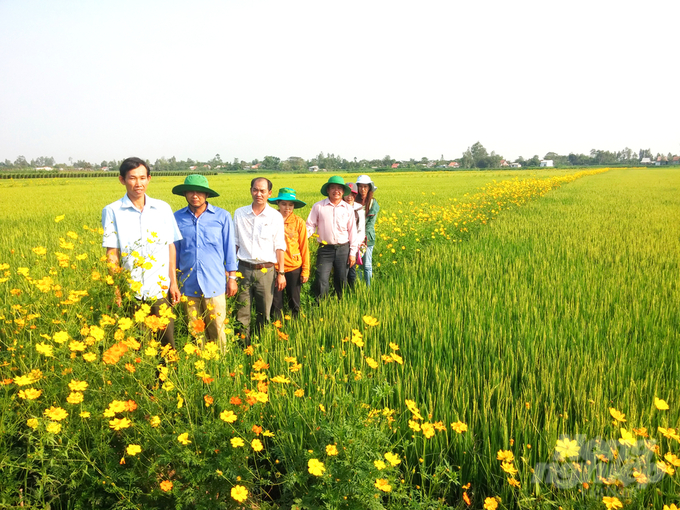
There are few models like “rice fields, flower banks” that farmers in the Mekong Delta have obtained and applied. Photo: Le Hoang Vu.
According to agricultural experts, there are typically three main groups of pests found in rice fields: diseases, weeds and animals, most of which are sucking insects. Normally, groups of sucking insects such as worms, leafhoppers, thrips, etc. can cause damage to rice at all stages of growth and development, so farmers often use toxic chemical drugs.
Many studies and production practices have shown that predatory parasites and insect-damaging fungi, also called natural enemies, play a very important role in paddy fields. In nature, natural enemies always inhibit the growth of pest populations. So when farmers misuse chemical drugs, they disrupt the ecosystem in the field and create a biological imbalance that makes pests more susceptible to disease. When pests break out, farmers increase the dose of chemical drug use, creating a vicious cycle.
By growing rice according to ecological technology, farmers will increase the number and activity of beneficial organisms or (natural enemies), contribute to increase biodiversity and balance the ecosystem on earth. paddy field. This is a technical advance applied in countries with advanced agricultural production worldwide, and also considered as an effective and safe pest control solution, helping rice farmers to save production costs and help protect ecological environment with safe and sustainable agricultural production.
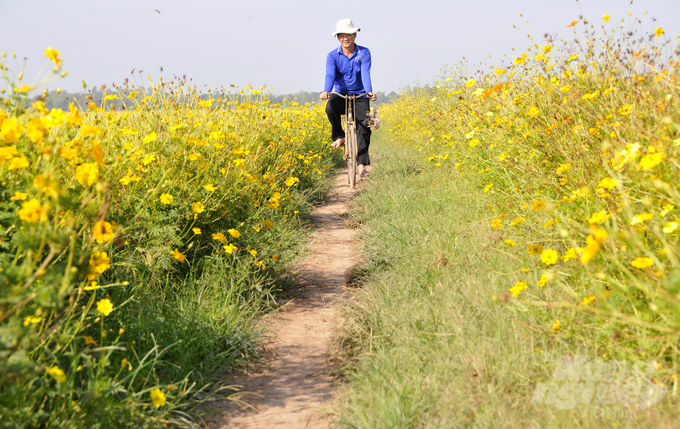
The “rice fields, flower beds” model not only attracts natural enemies and inhibits the development of pest populations, but also creates peaceful and poetic landscapes for rural villages. Picture: Le Hoang Vu.
In our country, from the winter-spring harvest of 2009-2010, the program “Community management of brown planthoppers and leaf rollers by ecological technology of paddy fields and flower beds” was implemented by the Plant Protection Department. This was first implemented in Tien Giang province and has since been carried over to many provinces in the Mekong Delta.
Recently, with the support and encouragement of the agribusiness, many advanced techniques have been implemented to change farmers’ production practices. Thereby, the technical process of rice cultivation according to ecological technology, also known as “rice field flower bank” model, has helped farmers protect themselves, attract natural enemies, control harmful organisms, reduce the use of agricultural pharmaceuticals and improve the quality of bulk rice improve and contribute to the protection of the ecological environment.
The “rice fields, flower banks” model was very attractive to farmers, spread quickly and gradually led to pesticide-free fields in the West.
Beautiful villages like in pictures
Mr. Ngo Van Hai in Phu Huu Township of An Phu District (An Giang Province) cultivates more than 5 hectares of rice. Previously, he had to invest tens of millions of dongs in nearly 8-9 chemical sprayers for each crop to prevent pests. But in recent years, since the application of organic rice farming techniques, everything has changed.
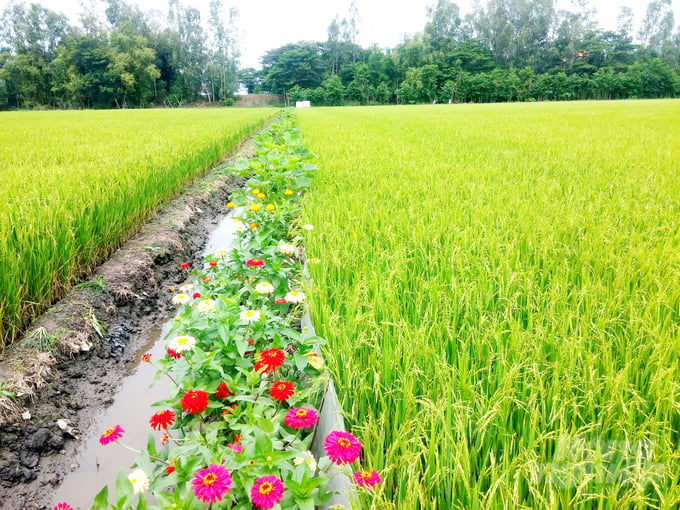
So far, almost 40,000 hectares of rice have been cultivated in the entire Mekong Delta according to the “rice fields, flower banks” model and the majority of the area is always sold by companies. Picture: Le Hoang Vu.
Not only Mr. Hay, but also most people who cultivate rice using organic technology in the Mekong Delta noticed that when applying this model during rice harvest, farmers only use agrochemicals to eradicate fungal diseases when necessary and use pesticides and planthoppers were minimized or not used.
In Long Thanh District 2, Thot Not District (Can Tho City), following the “rice fields, flower benches” model, people have developed into a flower village with nearly 30 participating households.
Mr. Nguyen Van Tien of Long Thanh 2 District, Thot Not District, who cultivates 2.5 ha of rice, said: In the past period, with the encouragement and guidance of the agribusiness industry, flowers such as imitation star, guava brooch and sunflower have been cultivated alongside chrysanthemum flowers are being grown at the field edge grown, but people also use the open land to grow more crops that please the market. In addition to effectively killing insects and reducing pesticides, “rice fields and flower benches” also contribute to green, clean and beautiful rural environment and create more stable income for people.
Mr. Tien calculated that by cultivating rice according to the “paddy fields, flower banks” model, farmers can reduce the amount of pesticides by more than 50%, saving about VND 300,000/rice per harvest, an increase of more than 20% 10% of their profit. Profit for rice farmers. This is a very significant number considering that rice cultivation is taking place under increasingly adverse weather conditions and the current high prices of agricultural inputs.
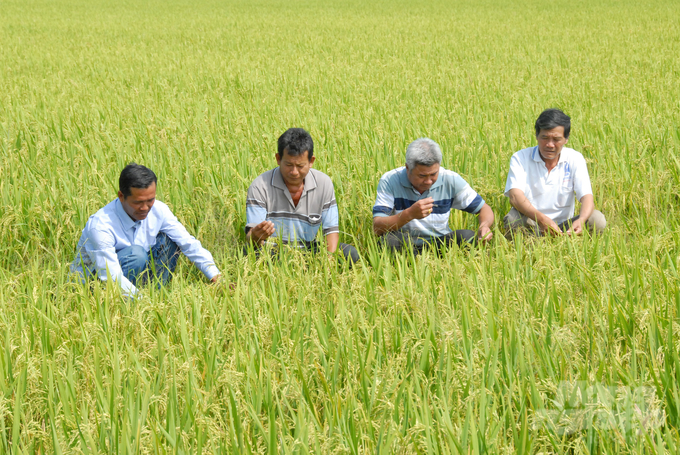
By cultivating rice according to the “rice fields, flower banks” model, farmers can reduce the amount of pesticides by more than 50%, saving about VND 300,000/rice per harvest. Picture: Le Hoang Vu.
Mr. Nguyen Van Hien, director of An Giang’s plantation and crop protection department, said that An Giang is one of the leading provinces in the Mekong Delta and has been cultivating and developing the “rice fields, flower banks” model.
In order to improve the efficiency of the model, in addition to planting flowers with many colors, nectar and pollen, experts also encourage planting more trees such as sesame, peanut, etc. in the coming period. Okra … Because in addition These crops not only serve as habitat and attract natural enemies, but can also bring significant additional income to farmers.
Ecological balance from the struggle for survival
According to Mr. Le Van Thiet, Deputy Director of the Department of Crop Protection, for the effective cultivation of rice according to the ecological technology model, it is first important that farmers use integrated pest management (IPM) and the “1 “must reduce 5” process, ie use certified seeds, reduce the amount of seeds sown, reduce the amount of nitrogen fertilizers, reduce pesticides, reduce the amount of water and the number of irrigation pumps, reduce losses during harvest and after harvest. Plan.
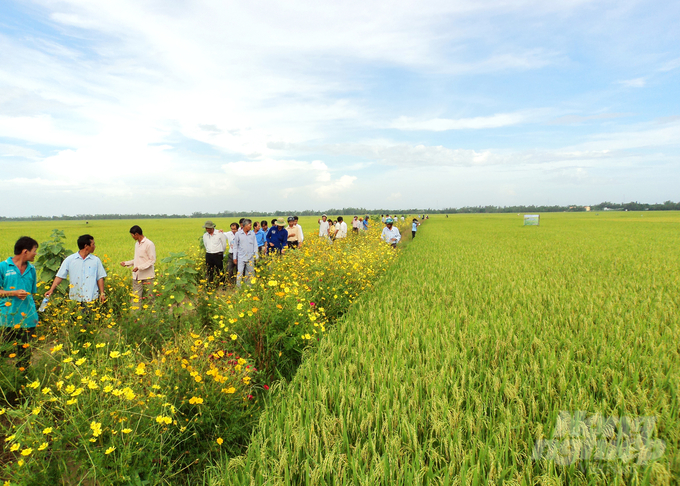
Rice cultivation according to the “rice fields, flower banks” model helps farmers save costs and protect the ecological environment and farmers’ health. Photo: Le Hoang Vu.
Utilizing the slope around the paddy field for planting flowers to maintain stability between pests and beneficials in the field. It is the struggle for survival between natural enemies and pests that creates an ecological balance in paddy fields and keeps the pest population at a low level without affecting the economic threshold. Farmers use limited or no chemicals to kill pests.
“The organic technology rice-growing model has really attracted farmers and has been imitated in provinces and cities in the Mekong Delta. So far, almost 40,000 hectares of rice are cultivated according to this model throughout the region, and most of the area is always sold by companies with stable products that meet the increasingly demanding needs of domestic and export markets. Password,” said Mr Le Van Thiet.
Participation in rice cultivation according to ecological technology with the “rice fields, flower banks” model has changed the consciousness of farmers in a positive direction. Most people have understood that spraying pesticides early, spraying them regularly, spraying pesticides to increase productivity…is a misconception that needs to be changed. On the other hand, ecological technology not only helps farmers improve pest control efficiency, but also contributes to building a sustainable, environmentally friendly farming system.
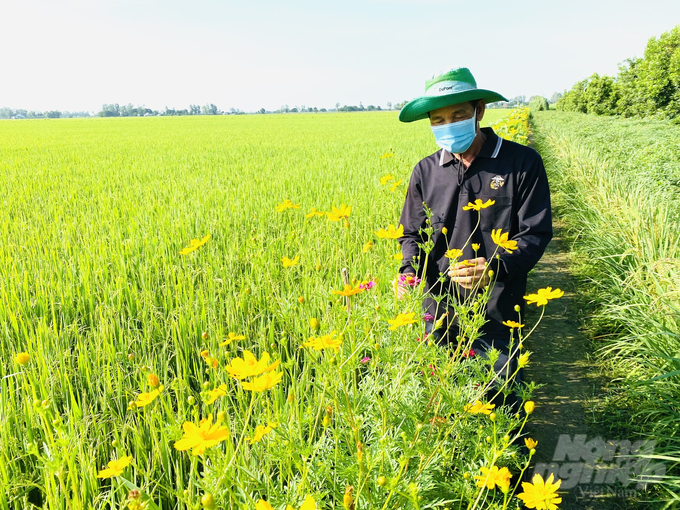
Rice cultivation according to ecological technology contributes to the fact that there are very few pests in the rice fields, the rural environment is green, clean and beautiful, and also creates more income for farmers. Picture: Le Hoang Vu.
According to Mr. Do Van Van, director of the Southern Center for Plant Protection (Public Protection Department), the organic technology rice cultivation model is currently being emulated in many provinces and cities in the Mekong Delta. Almost 40,000 hectares are cultivated according to the “rice fields, flower banks” model, which is a very small number compared to the rice cultivation area in the Mekong Delta. However, this efficient and environmentally friendly rice cultivation model has opened up many prospects for rice production in the country’s major rice regions.
In 2023, communities have also developed and applied this advanced technology on large fields, smart fields and fields under the program of 1 million hectares of high-quality rice in the Mekong Delta … to continue. Building fields that are not sprayed with pesticides. This is also the development trend of friendly, safe and sustainable agriculture.

